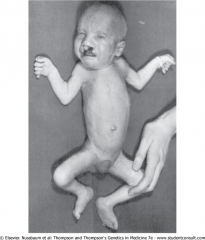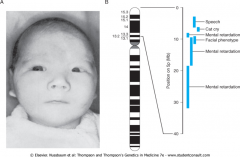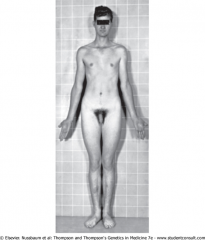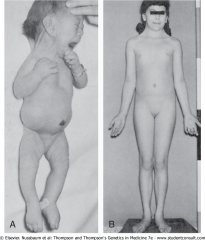![]()
![]()
![]()
Use LEFT and RIGHT arrow keys to navigate between flashcards;
Use UP and DOWN arrow keys to flip the card;
H to show hint;
A reads text to speech;
27 Cards in this Set
- Front
- Back
|
2 major genetic materials in humans:
|
1 nuclear chromosomes (46 chromosomes)
2. mitochondrial chromosomes (circular, 37 genes) |
|
|
Chromosomal make-up of humans
|
*22 pairs of autosomes
*2 sex chromosomes (XX, XY) 46, XY = designation (total # and sex) |
|
|
chromosomal differences btwn somatic and reproductive cells
|
somactic cells have 46 chromosomes (diploid)
oocytes/sperm cells (=gametes) have 23 nuclear chromosomes (haploid) |
|
|
How are chromosomes are replicated during mitosis
|
-DNA synthesized during S phase
-Sister chromatids form -Disjunction of sister chromatids during mitosis (M phase) |
|
|
How are chromosome segregated during meiosis I and meiosis II?
|
meiosis I: meiotic crossover (genetic recombination) occurs--> increasing genetic diversity in the gamete, disjunction of chromosomes occurs
meisosis II: disjunction of sister chromatids, chromosome number is reduced in half (back to original #) |
|
|
What are the consequences of non-disjunction during mitosis and meiosis
|
-Non-disjuction during MITOSIS results in one daughter cell ending up with an extra chromsome and one missing a chromosome = mosaicism= cell populations w/ diff genetic make-up (frequently occurs in cancer cells)
-Non-disjunction during MEIOSIS generates gametes w/ incorrect chromosome number, offspring will inherit abnormal chromosome, which can lead to spontaneous abortion or serious disease |
|
|
List basic types of karyotype deficiencies that lead to chromosomal abnormalities
|
-abnormal chromsome number
-structural abnormalities balanced (unequal crossover) unbalanced (deletions or insertions) |
|
|
Down syndrome
|
symptoms: short stature, short neck, flat nasal bridge, open mouth w/ protruding tongue, congenital heart disease, low IQ
karyotypes: 47, XX or XY, +21 (trisomy 21) (+=extra) *most common disease |
|
|
Trisomy 13 (Patau):
|

symptoms: mental retardation, failure to thrive, congenital heart problems, sloping forehead, cleft-lip (& palate), polydactyl (>5 fingers or toes), fist clenching, rocker bottom feet
karyotypes: 47, XX or XY, +13 |
|
|
Trisomy 18 (Edwards):
|

symptoms:mental retardation, failure to thrive, congenital heart problems, receding jaw, low-set malformed ear, clenched fist, rocker bottom feet
karyotypes: 47, XX or XY, +18 |
|
|
Cri du Chat:
(Autosomal deletion syndrome) |

symptoms: cat-like cry, mental & growth retardation, speech impairment, heart problems, small head, narrow eyes far apart, low-set ears
karyotypes: 46, XX or XY, del(5p) (caused by deletions in the p arm of chromosome 5) |
|
|
Different genetic causes of Down syndrome
|
1. mosaicism during early development (caused by non-disjunction during mitosis)--> 47, XX, +21 (95%)
2. Robertsonian translocation in a parent, translocation most commonly btwn 14 & 21--> 46, XX, rob(14;21),+21 (4%) 3. 21q21q translocation, long arms of two chromosome 21s join together 4. partial trisomy 21, only part of chromosome 21 is present in triplicate |
|
|
What is the Y chromosome gene that is the main regulator of male sexual development?
|
SRY gene= TDF (testis-determining factor)
*default sex is female, SRY leads to male sex development |
|
|
Explain how chromosomal abnormalities in the SRY gene can lead to abnormal sexual development
|
XX males-
incorrect crossover of SRY gene to the X chromosome, sterile (hypogonadism, azoospermia (no sperm in semen) XY females- loss of active SRY gene from the Y chromosome due to incorrect cross-over, deletion or mutation, sterile (streak gonad, no functional ovaries), secondary sex characteristics do not develop (no puberty) |
|
|
Explain the basic mechanism of X chromosome inactivation
|
Silence genes on one X chromosome to ensure similar X gene dosage btwn males and females.
-inactivation directed by X inactivation center (XIC) located on q arm of X chromosome -XIC produces large non-coding RNA (XIST) that initiates changes in histone composition & DNA methylation causing inactivation -random -occurs during early embryogenesis -daughter cells in mitosis inherit the Xi pattern -females are mosaic for X-linked gene expression |
|
|
Inactivated genes on Xi are not 100% silenced!! Where are most unsilenced genes located?
|
-distal end of p arm (pseudoautosomal region)
*both X chromosomes necessary for female sex develpment! Females are mosaic for X-linked gene expression |
|
|
What is uniparental disomy and what can it lead to?
|
when both chromosomes are inherited from the same parent
can lead to disorders involving genes under genomic imprinting |
|
|
What do most chromosomal abnormalities cause?
|
mental retardation and developmental problems
|
|
|
most frequent abnormal chromosome numbers (4)
|
Euploid (total # multiple of 23)
1. triploid- 69 = death 2. tetraploid- 92 = death Aneuploid (total # not multiple of 23) 3. trisomy- extra chromosome (common @ 21,18,13) 4. monosomy- missing chromosome (45X, Turner) |
|
|
Transcription factors SOX9 & DAX1, can also lead to XX males and XY females, each favor which sex?
|
SOX9- favors male (XX), loss of function mutation
DAX1- favors female (XY), gene duplication |
|
|
Klienfelter syndrome
(sex chromosome abnormality) |

symptoms: tall, feminine like stature, hypogonadism (infertile), some learning deficiencies
karyotype: 47, XXY |
|
|
Turner syndrome
(sex chromosome abnormality) |

symptoms: short stature, streak gonads, can't enter puberty, infertile, some learning difficulties, webbed neck, edema, wide chest (man-like)
karyotype: 45, X *46, XX mosaic is another karyotype for Turner that can be fertile |
|
|
Isochromosomes (i(Xq)), contain 2 long arms (q) of the X chromosomes, how are they formed?
|
Isochromosomes form by incorrect separation of sister chromatids during meiosis II.
|
|
|
Do mitochondrial or nuclear chromosomes have more chromosomes per cell?
|
mitochondrial
|
|
|
Do mitochondrial or nuclear chromosomes contain more genes?
|
nuclear
|
|
|
The Yp psuedoautosomal region on the Y chromosome contains what gene?
This region is present in _____ males and deleted in ____females |
SRY
present in XX males and deleted in XY females |
|
|
When the region of the Y chromosome containing AZFa, AZFb, and AZFc is deleted, what is the result?
|
semen does not contain sperm
(azoospermia) |

